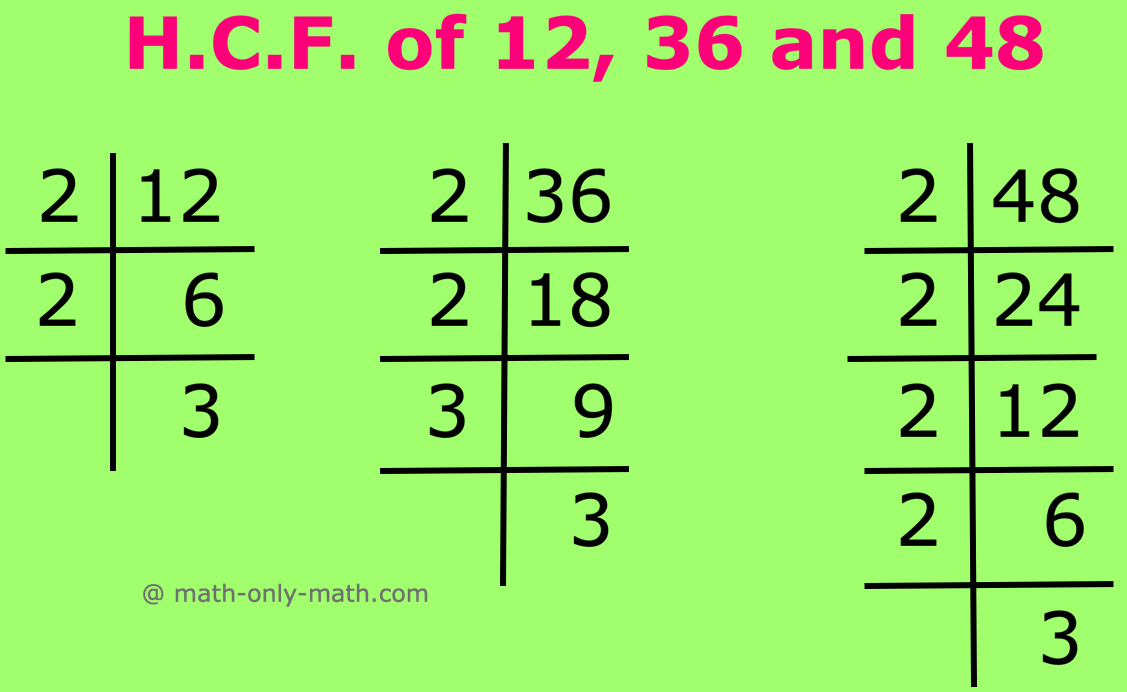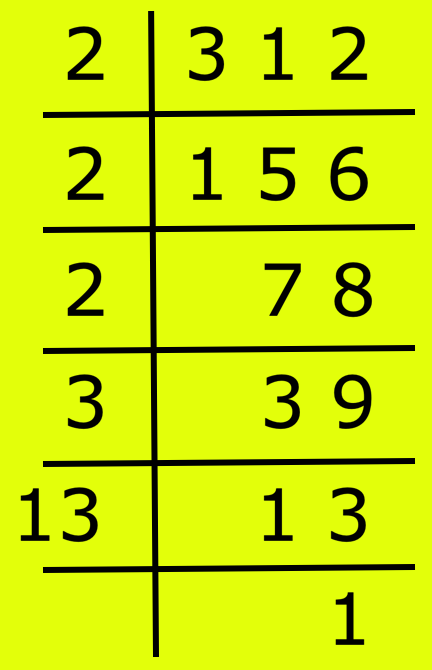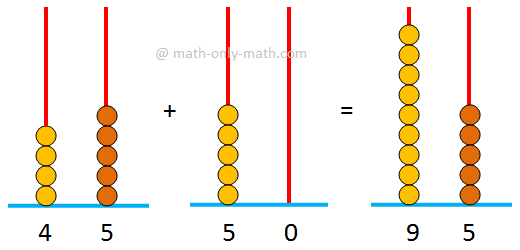Nature of the Roots of a Quadratic Equation
We will discuss here about the different cases of discriminant to understand the nature of the roots of a quadratic equation.
We know that α and β are the roots of the general form of the quadratic equation ax2 + bx + c = 0 (a ≠ 0) .................... (i) then we get
α = −b−√b2−4ac2a and β = −b+√b2−4ac2a
Here a, b and c are real and rational.
Then, the nature of the roots α and β of equation ax2 + bx + c = 0 depends on the quantity or expression i.e., (b2 - 4ac) under the square root sign.
Thus the expression (b2 - 4ac) is called the discriminant of the quadratic equation ax2 + bx + c = 0.
Generally we denote discriminant of
the quadratic equation by ‘∆ ‘ or ‘D’.
Therefore,
Discriminant ∆ = b2 - 4ac
Depending on the discriminant we shall discuss the following cases about the nature of roots α and β of the quadratic equation ax2 + bx + c = 0.
When a, b and c are real numbers, a ≠ 0
Case I: b2 - 4ac > 0
When a, b and c are real numbers, a ≠ 0 and discriminant is positive (i.e., b2 - 4ac > 0), then the roots α and β of the quadratic equation ax2 + bx + c = 0 are real and unequal.
Case II: b2 - 4ac = 0
When a, b and c are real numbers, a ≠ 0 and discriminant is zero (i.e., b2 - 4ac = 0), then the roots α and β of the quadratic equation ax2 + bx + c = 0 are real and equal.
Case III: b2 - 4ac < 0
When a, b and c are real numbers, a ≠ 0 and discriminant is negative (i.e., b2 - 4ac < 0), then the roots α and β of the quadratic equation ax2 + bx + c = 0 are unequal and imaginary. Here the roots α and β are a pair of the complex conjugates.
Case IV: b2 - 4ac > 0 and perfect square
When a, b and c are real numbers, a ≠ 0 and discriminant is positive and perfect square, then the roots α and β of the quadratic equation ax2 + bx + c = 0 are real, rational unequal.
Case V: b2 - 4ac > 0 and not perfect square
When a, b and c are real numbers, a ≠ 0 and discriminant is positive but not a perfect square then the roots of the quadratic equation ax2 + bx + c = 0 are real, irrational and unequal.
Here the roots α and β form a pair of irrational conjugates.
Case VI: b2 - 4ac is perfect square and a or b is irrational
When a, b and c are real numbers, a ≠ 0 and the discriminant is a perfect square but any one of a or b is irrational then the roots of the quadratic equation ax2 + bx + c = 0 are irrational.
Notes:
(i) From Case I and Case II we conclude that the roots of the quadratic equation ax2 + bx + c = 0 are real when b2 - 4ac ≥ 0 or b2 - 4ac ≮ 0.
(ii) From Case I, Case IV and Case V we conclude that the quadratic equation with real coefficient cannot have one real and one imaginary roots; either both the roots are real when b2 - 4ac > 0 or both the roots are imaginary when b2 - 4ac < 0.
(iii) From Case IV and Case V we conclude that the quadratic equation with rational coefficient cannot have only one rational and only one irrational roots; either both the roots are rational when b2 - 4ac is a perfect square or both the roots are irrational b2 - 4ac is not a perfect square.
Various types of Solved examples on nature of the roots of a quadratic equation:
1. Find the nature of the roots of the equation 3x2 - 10x + 3 = 0 without actually solving them.
Solution:
Here the coefficients are rational.
The discriminant D of the given equation is
D = b2 - 4ac
= (-10)2 - 4 ∙ 3 ∙ 3
= 100 - 36
= 64 > 0.
Clearly, the discriminant of the given quadratic equation is positive and a perfect square.
Therefore, the roots of the given quadratic equation are real, rational and unequal.
2. Discuss the nature of the roots of the quadratic equation 2x2 - 8x + 3 = 0.
Solution:
Here the coefficients are rational.
The discriminant D of the given equation is
D = b2 - 4ac
= (-8)2 - 4 ∙ 2 ∙ 3
= 64 - 24
= 40 > 0.
Clearly, the discriminant of the given quadratic equation is positive but not a perfect square.
Therefore, the roots of the given quadratic equation are real, irrational and unequal.
3. Find the nature of the roots of the equation x2 - 18x + 81 = 0 without actually solving them.
Solution:
Here the coefficients are rational.
The discriminant D of the given equation is
D = b2 - 4ac
= (-18)2 - 4 ∙ 1 ∙ 81
= 324 - 324
= 0.
Clearly, the discriminant of the given quadratic equation is zero and coefficient of x2 and x are rational.
Therefore, the roots of the given quadratic equation are real, rational and equal.
4. Discuss the nature of the roots of the quadratic equation x2 + x + 1 = 0.
Solution:
Here the coefficients are rational.
The discriminant D of the given equation is
D = b2 - 4ac
= 12 - 4 ∙ 1 ∙ 1
= 1 - 4
= -3 > 0.
Clearly, the discriminant of the given quadratic equation is negative.
Therefore, the roots of the given quadratic equation are imaginary and unequal.
Or,
The roots of the given equation are a pair of complex conjugates.
11 and 12 Grade Math
From Nature of the Roots of a Quadratic Equation to HOME PAGE
Didn't find what you were looking for? Or want to know more information about Math Only Math. Use this Google Search to find what you need.
Recent Articles
-
5th Grade Highest Common Factor | HCF | GCD|Prime Factorization Method
Mar 24, 25 03:40 PM
The highest common factor (H.C.F.) of two or more numbers is the highest or greatest common number or divisor which divides each given number exactly. Hence, it is also called Greatest Common Divisor… -
5th Grade Factors and Multiples | Definitions | Solved Examples | Math
Mar 23, 25 02:39 PM
Here we will discuss how factors and multiples are related to each other in math. A factor of a number is a divisor which divides the dividend exactly. A factor of a number which is a prime number is… -
Adding 2-Digit Numbers | Add Two Two-Digit Numbers without Carrying
Mar 23, 25 12:43 PM
Here we will learn adding 2-digit numbers without regrouping and start working with easy numbers to get acquainted with the addition of two numbers. -
Worksheet on 12 Times Table | Printable Multiplication Table | Video
Mar 23, 25 10:28 AM
Worksheet on 12 times table can be printed out. Homeschoolers can also use these multiplication table sheets to practice at home. -
Vertical Subtraction | Examples | Word Problems| Video |Column Method
Mar 22, 25 05:20 PM
Vertical subtraction of 1-digit number are done by arranging the numbers column wise i.e., one number under the other number. How to subtract 1-digit number vertically?






New! Comments
Have your say about what you just read! Leave me a comment in the box below. Ask a Question or Answer a Question.